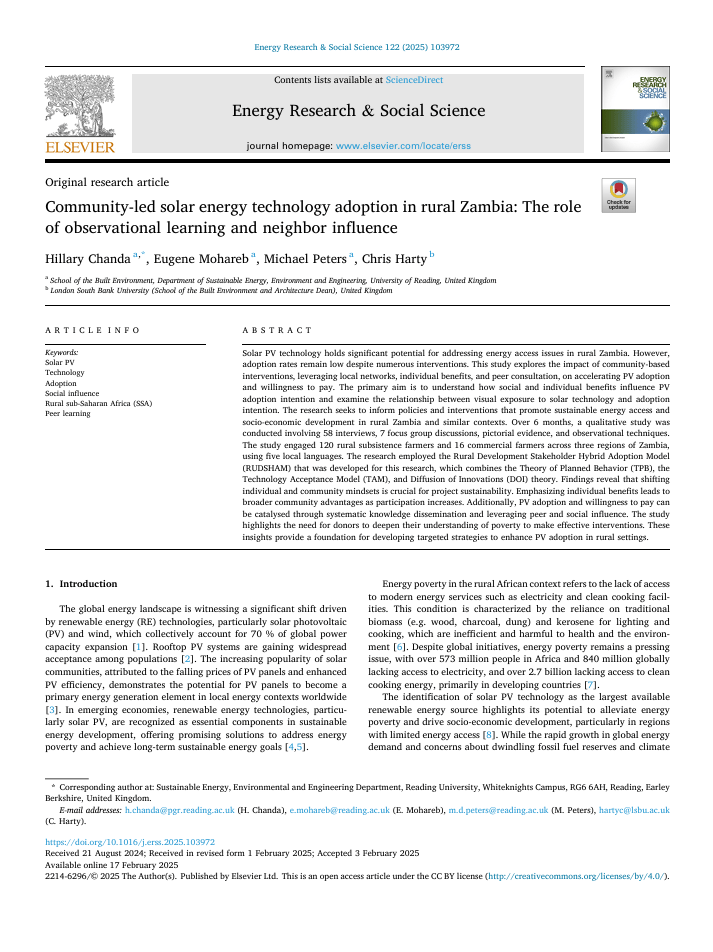Community-led solar energy technology adoption in rural Zambia: The role of observational learning and neighbor influence
 |
article Apr 2025 ; 16 pages
Aut. Hillary Chanda & Eugene Mohareb & Michael Peters & Chris Harty
Ed. ScienceDirect - Amsterdam
Téléchargeable sous format: PdF
Téléchargeable chez l'éditeur
Résumé:
La technologie photovoltaïque (PV) solaire offre un potentiel considérable pour répondre aux problèmes d’accès à l’énergie dans les zones rurales de la Zambie. Toutefois, les taux d’adoption restent faibles malgré de nombreuses interventions. Cette étude examine l’impact des interventions communautaires, en s’appuyant sur les réseaux locaux, les avantages individuels et les consultations entre pairs, pour accélérer l’adoption de la technologie PV et la disposition à payer. L’objectif principal est de comprendre comment les bénéfices sociaux et individuels influencent l’intention d’adopter cette technologie, et d’analyser la relation entre l’exposition visuelle à l’énergie solaire et cette intention.
La recherche vise à éclairer les politiques et les interventions destinées à promouvoir l’accès durable à l’énergie et le développement socio-économique dans les zones rurales de Zambie et dans des contextes similaires. Pendant six mois, une étude qualitative a été menée, comprenant 58 entretiens, 7 groupes de discussion, des preuves visuelles et des observations de terrain. L’enquête a impliqué 120 agriculteurs de subsistance en milieu rural et 16 agriculteurs commerciaux dans trois régions de Zambie, en utilisant cinq langues locales.
L’étude a mobilisé un modèle hybride d’adoption par les parties prenantes du développement rural (RUDSHAM), développé spécifiquement pour cette recherche. Ce modèle combine la Théorie du Comportement Planifié (TPB), le Modèle d’Acceptation Technologique (TAM) et la Théorie de la Diffusion des Innovations (DOI). Les résultats montrent qu’un changement des mentalités individuelles et communautaires est essentiel pour assurer la durabilité des projets. Mettre l’accent sur les bénéfices individuels favorise des retombées communautaires plus larges à mesure que la participation augmente. Par ailleurs, l’adoption de la technologie PV et la volonté de payer peuvent être stimulées par une diffusion systématique des connaissances et l’influence des pairs et du groupe social.
L’étude souligne l’importance pour les bailleurs de fonds de mieux comprendre la pauvreté afin de mettre en œuvre des interventions efficaces. Ces résultats offrent une base solide pour l’élaboration de stratégies ciblées visant à renforcer l’adoption du photovoltaïque dans les milieux ruraux. Abstract:
Solar PV technology holds significant potential for addressing energy access issues in rural Zambia. However, adoption rates remain low despite numerous interventions. This study explores the impact of community-based interventions, leveraging local networks, individual benefits, and peer consultation, on accelerating PV adoption and willingness to pay. The primary aim is to understand how social and individual benefits influence PV adoption intention and examine the relationship between visual exposure to solar technology and adoption intention. The research seeks to inform policies and interventions that promote sustainable energy access and socio-economic development in rural Zambia and similar contexts. Over 6 months, a qualitative study was conducted involving 58 interviews, 7 focus group discussions, pictorial evidence, and observational techniques. The study engaged 120 rural subsistence farmers and 16 commercial farmers across three regions of Zambia, using five local languages. The research employed the Rural Development Stakeholder Hybrid Adoption Model (RUDSHAM) that was developed for this research, which combines the Theory of Planned Behavior (TPB), the Technology Acceptance Model (TAM), and Diffusion of Innovations (DOI) theory. Findings reveal that shifting individual and community mindsets is crucial for project sustainability. Emphasizing individual benefits leads to broader community advantages as participation increases. Additionally, PV adoption and willingness to pay can be catalysed through systematic knowledge dissemination and leveraging peer and social influence. The study highlights the need for donors to deepen their understanding of poverty to make effective interventions. These insights provide a foundation for developing targeted strategies to enhance PV adoption in rural settings. Contents:
1. Introduction
2. Literature review
3. Theoretical underpinnings/models to inform the study
3.1. Rural development stakeholder hybrid adoption model (RUDSHAM)
3.1.1. Perceived ease (PE)
3.1.2. Perceived usefulness (PU)
3.1.3. Norms (NO)
3.1.4. Perceived behavior control (PBC)
3.1.5. Policy support (PS)
3.1.6. Economic cost (EC)
3.1.7. Community participation (CoP)
3.1.8. Prior preferences and practice (PP)
3.1.9. Green concern (GC)
3.1.10. Financial models of relevance (FMR)
3.2. RUDSHAM informing methodology
3.2.1. Perceived ease (PE)
3.2.2. Perceived usefulness (PU)
3.2.3. Norms (NO)
3.2.4. Perceived behavior control (PBC)
3.2.5. Policy support (PS)
3.2.6. Economic cost (EC)
3.2.7. Community participation (CoP)
3.2.8. Prior preferences and practice (PP)
3.2.9. Green concern (GC)
3.2.10. Financial models of relevance (FMR)
4. Research methodology: Research strategy and data collection methods
5. Research findings
5.1. Social influence dynamics
5.2. Community engagement deficit
5.3. Ownership and sustainability
5.4. Solar quality challenges (counterfeits)
5.5. Entrenched poverty and tradition
5.6. Aid effectiveness and the importance of sustainability
5.7. Project misalignment and dead aid: Challenges of implementation
6. Case studies of technological adoption despite resource scarcity
6.1. Mobile phones, solar PV phone chargers, solar PV lighting systems and/or solar PV torches
6.2. Piped water adoption in rural setup
7. Interpretation and discussion
7.1. Observational learning and peer influence
7.2. Dependency and sustainability
7.3. Mindset transformation and poverty
7.4. Donor motivations and sustainable investments
7.5. Information dissemination and community consultation
8. Recommendations
8.1. Leverage peer influence for technology uptake
8.2. Foster Community ownership and participation through strengthened governance structures
8.3. Integrate mindset transformation into development programs
8.4. Promote policy support for sustainable investments
8.5. Enhance information dissemination and community consultation
8.6. Develop financial models for affordable access
8.7. Tailor solar solutions to local needs
9. Conclusion
Public-Cible:
Mots clefs: |
développement rural (CI) (DT) (OP) (ope) , électrification (CI) (DT) (OP) (ope) , énergie solaire (CI) (DT) (OP) (ope) |
Pays concerné: |
Editeur/Diffuseur: |
|
ScienceDirect
-
Elsevier - Amsterdam - Pays Bas |
En cas de lien brisé, nous le mentionner à communication@pseau.org